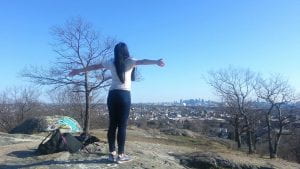The image above is of meat being sliced on a cutting board by a person wearing a chef hat. They have one foot on the cutting board while balancing a knife getting ready to cut another slice of meat. If you look closely, the person doesn’t have any gender identifying characteristics. The image implies that anyone, men and women are the ones in control of what they eat. Society is not in control of what foods should be gendered. Another interpretation is that both men and women are the authority figure in the human-animal relationship.
Zoe Elsenberg’s Meat Heads: New Study Focuses on How Meat Consumption Alters Men’s Self-Perceived Levels of Masculinity talks about something as simple as eating meat equates to a man’s masculinity. She goes on to say that society has marketed meat for men and salads for women. In her article, she advises us to google “men eating” versus “women eating”, the results prove her point.
As a kid, I always watched movies where the man is in charge of handling the meat. I don’t remember a specific movie, but I’m thinking of that one stereotypical, cliche scene in every holiday movie where the man is standing at the front of the table getting ready to carve the turkey. I didn’t think much of this as a kid. I assume that the woman would prepare the food and the man carved the turkey, trying to insert some form of participation in the preparation process.
I’ve also come to know about food products marketed towards men and women. I’ve seen words like “low calorie” marketed on food products catered towards women, as if women only eat enough to stay thin. I’ve also seen pre and post workout protein bars/powders marketed towards men, this implying that men should workout to get bigger, not healthier.
Greta Gaard argues in Ecofeminism on the Wing: Perspectives on Human-Animal Relations that “to be a pet is to have all one’s life decisions controlled by someone else … if the situation were offered to humans, we’d call it slavery” (Gaard 20). She focuses on the oppression of animals with the tale of Bella and relates it to women, as “feminists and ecofeminists alike have noted the ways that animal pejoratives are used to dehumanize women, pointing to the linguistic linkage of women and animals in such derogatory terms for women” (Gaard 20). Gaard starting her paper off with Bella (meaning beautiful in Italian), a green and yellow canary in a golden cage is her essentially implying that women are put in cages to be admired, but not cared for.
While Deanne Curtin also had the same views on the human-animal relationship to Gaard, she also brought a moral perspective into it. Curtin believes in what she calls contextual moral vegetarianism, she says “there are persons who have a choice of what food they want to eat” (Curtin 8).

